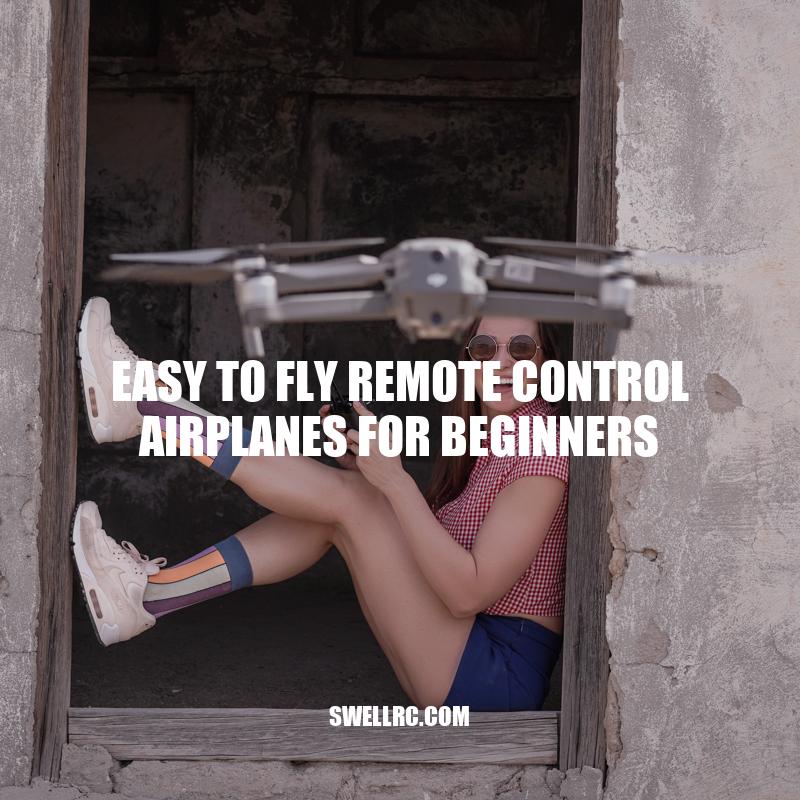Easy-to-Fly Remote Control Airplanes for Beginners: A Guide
Remote control airplanes can provide hours of fun for beginners who want to experience the thrill of flying without having to leave the ground. If you’re new to the hobby, you might feel intimidated by the complex terminology, technology, and skills required. However, there are many easy to fly remote control airplanes that are designed for beginners and offer a safe and enjoyable introduction to the world of RC aviation. By choosing the right plane, you can learn the basics of piloting, gain confidence, and progress to more advanced models as your skills improve.
One of the main factors that affect the ease of flying a remote control airplane is its power source. There are two main types of RC planes: electric and gas. Electric-powered planes are generally easier to operate and maintain, quieter, and cleaner than gas-powered ones. They can be charged from a regular outlet or a portable battery, and have instant power that allows for quick takeoffs and agile maneuvers. They also have fewer mechanical parts and require less maintenance than gas-powered planes, which can be noisy, messy, and complicated to start and tune. Moreover, electric planes can be flown in more places, such as parks, backyards, or indoor venues, as they don’t emit fumes or disturb other people or wildlife.
Easy to Fly Models for Beginners
When choosing an RC airplane that is easy to fly, there are a few key features to keep in mind. Look for planes that have beginner-friendly designs, simplified controls, and safety features to prevent crashes and damage. Some popular models for beginners include:
- HobbyZone Champ RTF
- Dromida Twin Explorer RTF
- E-flite Apprentice S 15e RTF
- Flyzone Micro Calypso RTF
- Hubsan X4 H107D+ FPV
All of these planes are electric-powered, lightweight, and come with everything you need to fly, including a remote controller, a battery, and a charger. Some of them also have additional features such as a stabilizing gyro, an altitude hold function, or a camera that allows for first-person view flying. You can find these and other easy to fly RC planes at hobby stores, online marketplaces such as Amazon, or specialized websites such as Horizon Hobby or Tower Hobbies. Make sure to read the reviews and specifications carefully, and choose a plane that suits your budget, skill level, and preferences.
Tips for Successful Flying
Once you have picked your plane and location, there are a few tips that can help you have a safe and enjoyable flight experience:
- Start with short and simple flights, and gradually increase the duration and complexity.
- practice your takeoffs and landings separately before attempting a full flight.
- Avoid flying near obstacles, power lines, or people, and maintain a safe distance from other pilots.
- Always check your battery life and signal strength before and during your flight, and make sure to land safely before the power runs out or the signal is lost.
- Join a local RC club or online community to get guidance, feedback, and inspiration from other pilots.
By following these tips and practicing regularly, you can become a skilled and confident RC pilot and enjoy the many benefits of this exciting hobby.
What is the best RC plane for beginners?
- The E-flite Apprentice S 15e RTF is a great choice for beginners with its easy flight control and durability.
- The Hobbyzone Sport Cub S RTF is another option for beginners with its simple controls and crash-resistant design.
- The FMS Sky Trainer 182 is a versatile beginner’s RC plane that can be flown in various weather conditions and is easy to repair.
When choosing a beginner’s RC plane, it’s important to consider the level of experience and the flying environment. Visit websites such as Horizon Hobby, Tower Hobbies, and Motion RC for a wider selection of beginner-friendly RC planes.
Maintenance and Repair of RC Planes
Like any machine, remote control planes require regular maintenance and occasional repairs to keep them in good condition. Here are some tips and tools for maintaining your RC plane:
Cleaning
| Tools | Procedure |
|---|---|
| Compressed air can or electric blower | Blow away any dirt, debris, or moisture from the inside and outside of the plane. |
| Damp cloth | Wipe the exterior of the plane gently to remove any stains or residues. |
| Silicone spray or oil | Apply a thin layer on the hinges, gears, and moving parts to reduce friction and prevent rust. |
Inspecting
- Check the battery and charger for any damages, leaks, or malfunctions, and replace or repair them as needed.
- Inspect the motor, blades, and propeller for any cracks, bends, or looseness, and tighten, balance, or replace them as needed.
- Check the receiver, transmitter, and control surfaces for any loose wires, broken connections, or interference, and repair or replace them as needed.
Repairing
- Invest in a basic repair kit that includes tools such as pliers, screwdrivers, glue, tape, and spare parts such as wires, connectors, and screws.
- Follow the manufacturer’s instructions or consult online resources such as YouTube tutorials or forums for common repairs such as replacing a propeller or resetting a gyro.
- Be patient, observant, and cautious when repairing your RC plane, and don’t rush or force any parts.
By paying attention to the maintenance and repair of your RC plane, you can prolong its lifespan, prevent accidents and crashes, and enjoy a smoother and safer flying experience. Some websites that offer RC plane maintenance and repair services, as well as spare parts and tools, include MotionRC, RC Superstore, and AMain Hobbies.
What is the maintenance of an airplane?
Airplane maintenance refers to the regular upkeep of an aircraft to ensure it is safe to fly, complies with aviation regulations, and performs optimally. Maintenance involves comprehensive inspections, repairs, replacements, and servicing of various components, systems and structures. The goal is to identify and fix any issues before they become safety risks or result in expensive repairs.
Maintenance activities can be categorized as routine maintenance, progressive maintenance, and checks or inspections. Routine maintenance includes daily, weekly, and monthly checks such as cleaning, lubrication, and equipment tests. Progressive maintenance involves scheduled replacement of parts or components based on their expected lifespan or hours of use, while checks or inspections involve more thorough assessments of the aircraft’s condition, such as pre-flight inspections, annual inspections, or heavy maintenance intervals.
Airplane maintenance is performed by licensed maintenance professionals in accordance with federal regulations stipulated by the Federal Aviation Administration (FAA). Adhering to proper maintenance practices is crucial for ensuring aircraft safety, proper functioning and longevity.
For more information, visit the FAA website or check out aviation maintenance products and services offered by companies such as Boeing or AAR Corp.
Safety and Regulations for Flying RC Planes
While flying a remote control plane can be fun and exhilarating, it can also pose some risks and demands some responsibilities. Here are some safety tips and regulations to keep in mind when flying your RC plane:
Safety
- Choose a suitable location that is away from populated areas, power lines, trees, and obstacles, and has enough open space for your plane to fly without endangering people, animals, or property.
- Check the weather conditions before flying and avoid windy or rainy days that can affect your visibility, control, and stability.
- Wear protective gear such as safety glasses, gloves, and closed-toe shoes to prevent any injuries from the propeller, battery, or other objects.
- Follow the manufacturer’s instructions and precautions and respect the limitations and capabilities of your plane.
- Be mindful of other hobbyists and pilots around you and communicate with them if necessary.
Regulations
The Federal Aviation Administration (FAA) has established some rules and guidelines for flying unmanned aerial vehicles (UAVs) or drones, including RC planes. Here are some key points to keep in mind:
- Register your drone if it weighs more than 0.55 pounds and less than 55 pounds using the FAA’s online registration system.
- Follow the FAA’s safety guidelines such as flying below 400 feet, flying within visual line of sight, and flying away from airports and restricted airspace.
- Observe the specific rules and regulations of your state, county, or city regarding the use and operation of drones in public areas.
- Be aware of the potential privacy and security issues related to the use of drones and respect the rights and privacy of others.
By following these safety tips and regulations, you can ensure a responsible and enjoyable flying experience with your RC plane. Some websites and resources that provide more information about drone safety and regulations, as well as online courses and exams for becoming a certified drone pilot, include the FAA’s UAS website, the Academy of Model Aeronautics, and Drone Pilot Ground School.
Can I fly my RC plane anywhere?
It is not legal to fly your RC plane anywhere you want. The laws and regulations regarding drone and RC plane flying vary depending on where you are located. Generally, you can only fly your drone or RC plane in designated areas, such as parks or RC flying clubs. Flying in restricted areas such as airports, national parks or residential areas is prohibited. It is important to check with your local authorities for regulations and rules regarding drone and RC plane flying.
For more information on drone and RC plane regulations, you can visit the Federal Aviation Administration (FAA) website.
Maintenance and Upgrades for RC Planes
Like any other machines, remote control planes require regular maintenance and occasional upgrades to stay in good working condition and improve their performance. Here are some tips and options to consider:
Maintenance
- Clean your plane after each flight or whenever it accumulates dirt, dust, grass, or other debris that can affect its movements and balance. Use a soft cloth or brush and mild detergent or alcohol to wipe or spray the surface, and avoid using water or harsh chemicals that can damage the electronics or the structure.
- Check and replace the battery and charger if they start to show signs of wear or malfunction such as swelling, overheating, or insufficient power. Use only the recommended and compatible parts and store them in a cool and dry place to avoid moisture and heat damage.
- Inspect and repair the propeller, motor, and other components if they get damaged or worn out, or if they make unusual noises or vibrations. Refer to the manufacturer’s manual or guide for the specific instructions and tools needed, or seek professional help if necessary.
- Adjust and fine-tune the control linkage and the servo arms if they are misaligned or imprecise. Use a servo tester or a radio control system to check the range and accuracy of the signals, and make the necessary adjustments using pliers or screwdrivers.
Upgrades
Depending on your skills and preferences, you can also upgrade your RC plane by adding or replacing some parts or features that can enhance its speed, agility, or endurance, or that can make it more versatile or fun to fly. Here are some options to explore:
- Install a higher capacity battery that can provide more power and longer flight times, or a smart battery that can monitor and balance the cells, or a LiPo battery that can be lighter and more efficient.
- Replace the stock motor with a brushless or a more powerful motor that can increase the thrust and speed of your plane, or with a quieter motor that can reduce the noise and vibration.
- Upgrade the propeller to a larger or a more durable propeller that can improve the lift and the responsiveness, or to a folding or a variable pitch propeller that can allow you to adjust the pitch and the efficiency.
- Add some accessories such as lights, cameras, or a parachute release mechanism that can add some creativity and functionality to your plane, or that can make it more visible and safe.
By keeping your RC plane well-maintained and updated, you can extend its lifespan and enjoy a smoother and more exciting flying experience. Some websites and resources that offer RC plane parts, tools, guides, and forums, include Horizon Hobby, Motion RC, and RCGroups.
How can I improve my RC flight?
Here are some tips to improve your RC flight:
- Practice regularly to improve your skills and muscle memory.
- Choose an appropriate aircraft for your skill level.
- Adjust the control throws and expo settings according to your preferences.
- Use a simulator to practice flying without risking damage to your aircraft.
- Learn about aerodynamics and how different factors affect the flight of your aircraft.
There are also websites and products available that can help improve your RC flight skills, such as RC Flight School and RC flight simulators like RealFlight or Phoenix RC.
Fly Safe and Have Fun
Flying remote control airplanes can be a thrilling and rewarding activity, but it also involves some risks and responsibilities. Here are some general tips and guidelines to follow:
- Read and understand the manufacturer’s instructions and warnings before flying your plane.
- Choose a suitable location that is clear of obstacles, people, and animals, and that has enough space and visibility for your plane.
- Check the weather conditions and avoid flying in strong winds, rain, or low visibility.
- Use proper protection such as eye goggles, gloves, and helmet, especially when handling the propeller or the motor.
- Be aware of your surrounding and do not fly near airports, military bases, or other restricted areas.
- Respect the privacy and property of others and avoid flying over or near private land without permission.
- Start with low altitude and slow speed, and gradually increase the height and the speed as you gain confidence and experience.
- Practice emergency procedures and landing techniques, and always have a backup battery or a spare propeller if possible.
Conclusion
In conclusion, remote control airplanes can offer a fun and challenging way to explore the skies and improve your piloting skills. By starting with an easy to fly model such as an electric-powered RTF plane or a glider, and by following the basic maintenance and safety guidelines, you can avoid crashes and accidents, and enjoy the freedom and excitement of flying. Whether you fly solo or with a group of enthusiasts, remote control airplanes can also provide a social and creative outlet, and a chance to learn, experiment, and bond with others who share your passion. So why not give it a try and soar higher?



